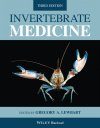About this book
Presented in full colour for the first time, Invertebrate Medicine is the definitive resource on husbandry and veterinary medicine in invertebrate species. Presenting authoritative information applicable to both in-human care and wild invertebrates, this comprehensive volume addresses the medical care and clinical condition of the most important invertebrate species – providing biological data for sponges, jellyfish, anemones, snails, sea hares, corals, cuttlefish, squid, octopuses, clams, oysters, crabs, crayfish, lobsters, shrimp, hermit crabs, spiders, scorpions, horseshoe crabs, honey bees, butterflies, beetles, sea stars, sea urchins, sea cucumbers, various worms, and many other invertebrate groups.
The extensively revised third edition contains new information and knowledge throughout, offering timely coverage of significant advances in invertebrate anaesthesia, analgesia, diagnostic imaging, surgery, and welfare. New and updated chapters incorporate recent publications on species including crustaceans, jellyfishes, corals, honeybees, and a state-of-the-science formulary. In this edition, the authors also discuss a range of topics relevant to invertebrate caretaking including conservation, laws and regulations, euthanasia, diagnostic techniques, and sample handling.
Edited by a leading veterinarian and expert in the field, Invertebrate Medicine, third edition:
- Provides a comprehensive reference to all aspects of invertebrate medicine
- Offers approximately 200 new pages of expanded content
- Features more than 400 full-colour images and new contributions from leading veterinarians and specialists for each taxon
- Includes updated chapters of reportable diseases, neoplasia, sources of invertebrates and supplies, and a comprehensive formulary
The standard reference text in the field, Invertebrate Medicine, third edition is essential reading for practising veterinarians, veterinary students, advanced hobbyists, aquarists and aquaculturists, and professional animal caretakers in zoo animal, exotic animal, and laboratory animal medicine.
Contents
Chapter 1. Introduction
Chapter 2. Porifera
Chapter 3. Coelenterates
Chapter 4. Reef Systems (new chapter to focus on corals/other marine invertebrates in captivity)
Chapter 5. Platyhelminths
Chapter 6. Gastropods
Chapter 7. Cephalopods
Chapter 8. Bivalves
Chapter 9. Annelids
Chapter 10. Limulus
Chapter 11. Spiders
Chapter 12. Scorpions
Chapter 13. Crustaceans
Chapter 14. Myriapods
Chapter 15. Insects
Chapter 16. Honey Bees (new chapter)
Chapter 17. Butterfly Houses(new chapter)
Chapter 18. Nematodes
Chapter 19. Chaetognaths
Chapter 20. Echinoderms
Chapter 21. Urochordates
Chapter 22. Diagnostic Techniques and Sample Handling
Chapter 23. Laws and Regulations
Chapter 24. Euthanasia (1E covered as an appendix; separate chapter now appropriate)
Chapter 25. Welfare (new chapter)
Appendix A. Sources of invertebrates and supplies (new appendix)
Appendix B. Neoplasia
Appendix C. Reportable Diseases
Customer Reviews
Biography
Gregory A. Lewbart, MS, VMD, Dipl. ACZM, Dipl. ECZM (Zoo Health Mgt.) is a Professor of Aquatic, Wildlife, and Zoological Medicine in the Department of Clinical Sciences at the College of Veterinary Medicine, North Carolina State University in Raleigh, NC, USA.


































